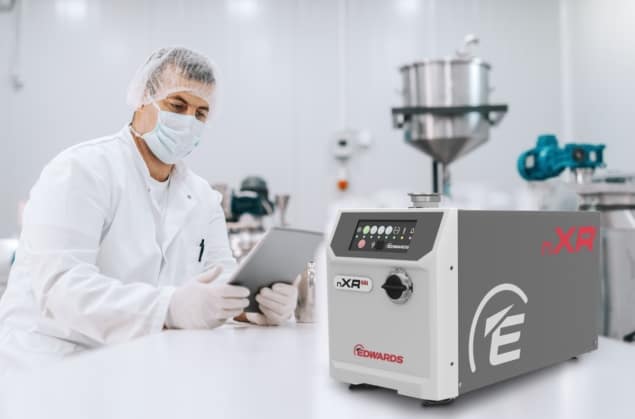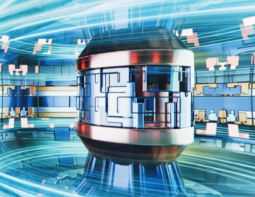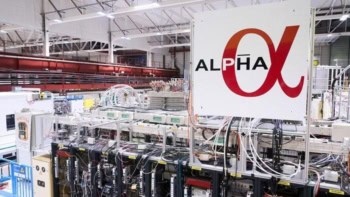Edwards reckons its nXRi dry vacuum pumps represent a win-win for scientists, enhancing their research productivity while lowering laboratory operating costs

Customer choice is right up there as a competitive differentiator for the vacuum specialist Edwards – and beyond that, how best to match its diverse user base with the right product and the right functionality for the job in question. A case in point is the manufacturer’s growing family of dry vacuum pumps, a core enabling technology for analytical instrumentation OEMs (in their electron microscopy and mass spectrometry systems), high-energy physics laboratories (across their accelerators, beamlines and laser systems) and a range of R&D and industrial applications (including coating systems, gel drying, gas recovery and plenty more besides).
To service that broad spectrum of requirements, Edwards’ portfolio of dry vacuum pumps must be similarly broad in scope – more choice, more options ultimately translating into more scientific, OEM and industrial end-users. That’s the rationale underpinning the manufacturer’s latest family of dry pumps – the nXRi series – with initial variants providing pumping speeds of either 60 or 90 m3/h. Equally significant are the nXRi’s compact footprint (494x301x217 mm) and weight (29 kg) which, taken together, enable the pumps to fit easily under a laboratory benchtop while ensuring a mobile vacuum solution for changing R&D workflows and environments.
“The nXRi has the highest pumping density on the market, delivering up to four times more pumping speed versus similarly sized dry pumps,” claims Dave Goodwin, senior product manager for scientific vacuum at Edwards. “Our aim is to offer customers greater choice, with many of them already bought into the advantages of dry pumps – not least the fact that they’re quiet, oil-free and easy to maintain.” The nXRi pump, for example, is maintenance-free for up to five years, with no tip-seal or oil change translating into extended uptime and lower operating costs for research labs and industry users.
Bridging the gap
The nXRi product line is, of course, the latest chapter in a running back story. Up until 2017, the Edwards scientific dry-pump portfolio (small, single-phased, air-cooled units) was dominated by scroll pumps (the XDS and nXDS product lines), which provide pumping speeds in the range from 6 to 40 m3/h. At this point, however, the vendor introduced the nXLi family of multistage roots pumps, offering pumping speeds from 110 to 200 m3/h, with all the associated benefits of dry-pump technology. That diversification was driven, in large part, by instrumentation OEMs seeking higher-performance pumping products for integration into their commercial mass spectrometers.

As such, the nXRi product line fills an obvious gap in the Edwards dry-pump portfolio – between the largest scroll pump (at 40 m3/h) and the smallest multistage roots pump (at 110 m3/h) – with a compact-footprint platform that’s easy to move around the lab. “We’ve now reached a point where the nXRi pumps have an even smaller footprint than our compact nXDS scroll pumps, providing up to a factor of four improvement in terms of pumping density,” explains Alexander Kaiser, Edwards’ global product manager for primary pumps (including responsibility for nXRi and nXLi).
There are also the running costs and environmental impacts to consider. The nXRi pumps are efficient, low-power units that generate a lot less heat and noise compared with traditional oil-sealed pumps – a win all round and in line with Edwards’ commitment that new pumping technologies should be more environmentally friendly versus the previous-generation products that they replace.
“For large labs, running banks of mass spectrometers 24/7, the nXRi pumps will mean a significant reduction to their operational costs for electrical power and air-conditioning units,” notes Kaiser. A laboratory operating a mass spectrometer using two big 40 m³/h rotary vane pumps, for example, can now think about streamlining that pumping set-up with a single nXRi unit (operating at 90 m³/h). “The nXRi is more compact, creates less noise and can save the customer upwards of £1000 per year in energy costs,” Kaiser adds.
Synchronized roadmaps
Operational benefits notwithstanding, it’s evident that the Edwards approach to new product innovation – for the nXRi pumps as well as the rest of the dry-pump portfolio – is rooted firmly in a continuous-improvement mindset and ongoing dialogue with the customer base. Think collaborative product development. “We’re in regular contact with customers to ensure our near- and long-term technology roadmaps align with their requirements,” Goodwin explains. “The goal is to synchronize so that we’re bringing through the right products, features and functionality when they need it.”
At the heart of that collective conversation is Edwards’ Global Technology Centre (GTC) in Burgess Hill, UK. Within a diversified and global R&D effort, the GTC employs a team of scientists and engineers dedicated to core technology development and validation across all of Edwards’ product lines, including the dry-pump portfolio. While part of the GTC’s remit is to address technical requirements coming in from the end-users, the centre also spends at least half of its time working on long-range blue-sky R&D – with a chunk of the latter driven by the GTC team eyeing more speculative commercial opportunities.

Turbomolecular pumps: diverse customers drive advanced performance
“Often the customer will come to us with a technical challenge,” says Goodwin. “We’ll take those inputs on board and endeavour to solve their problems by adapting existing products or developing new ones.” For the dry-pump portfolio, the response is shared across the wider innovation ecosystem at Edwards, pulling in product managers like Goodwin and Kaiser, GTC engineers, as well as Edwards’ experts located around the globe. “The task is to get a technology demonstrator product into the customer for feedback at an early stage, so that we can be sure we are heading in the right direction,” adds Goodwin.
Kaiser, for his part, is encouraged by the commercial reception to date for the nXRi family of pumps – and that’s despite the product launching in February as the coronavirus pandemic accelerated across Europe. Given the ongoing Covid restrictions, Kaiser and colleagues are focusing much of their promotional efforts on customer webinars as well as online and social videos. “When users see the nXRi pump running and realize it’s operating with speeds of up to 90 m³/h – this is what really impresses them,” he concludes. “It’s a completely different proposition to what they’re expecting in terms of the compact size, noise levels, maintenance, running costs and hence the overall environmental footprint.”
- For further information, see the nXRi technical briefing and data sheets plus the launch video below.




